A look back at GM’s hottest hardtops – The “Bubble Top” invasion

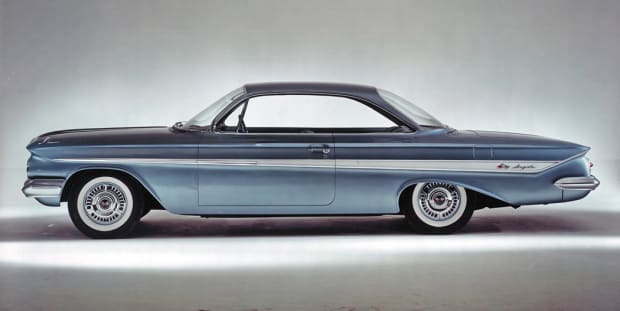
GM Media Archive
One of the more interesting automotive styling ideas to emerge in the 1950s was the “bubble top.” It was a popular concept in the early 1960s among customizers such as Daryl Starbird, who completed his first bubble-topped full custom (the Predicta) in early 1960. Inspiration for the bubble-top theme most likely came from fighter planes of the time, such as the F-80 Shooting Star and the F-86 Sabre Jet.
General Motors debuted various bubble-top concept cars at its traveling auto show, the GM Motorama, with cars such as the 1954 Pontiac Bonneville Special, 1956 Buick Centurion and its trio of turbine-powered Firebird concepts. Ford Motor Co. also exhibited concept cars with the bubble-top theme, such as the 1955 Lincoln Futura (the car altered into the “Batmobile” for the ’60s “Batman” TV show). Automotive writers predicted that bubble-topped cars would soon be in production. However, common sense prevailed; driving a car with a transparent roof was like driving a greenhouse on wheels, as was shown with the 1954-’56 Ford Skyliner and 1954-’55 Mercury Skyliner featuring a tinted transparent roof panel. Even tinting the Plexiglas and including a retractable roof shade did not solve the interior heating problem.
The idea did not simply go away, though. Steel-roofed, semi-bubble-top cars emerged from designers’ drawing boards in the latter part of the 1950s. For instance, GM’s 1959 models had wraparound windshields that arched up into the steel roof, and curved rear glass that had the profile of a bubble top. GM took the idea to its apex more than six decades ago with its 1961 two-door hardtop models that made use of the full-size B-body design. These cars are often referred to as a “bubble top.” (The two-door hardtops using the longer C-body — Oldsmobile’s Ninety-Eight, Buick’s Electra/Electra 225 and Cadillac’s Series 62 coupe and Coupe deVille — had a slightly different rear window and are generally not considered bubble tops.) The 1961 B-body two-door hardtops are among the most desirable of GM’s early-1960s automobiles, especially Chevrolet’s 1961 Impala and Pontiac’s 1961 Ventura, which are at the top of many enthusiasts’ “want” lists. Chevrolet kept the bubble-top roof once more, in 1962 — but only for the Bel Air Sport Coupe — then it was gone from GM in favor of more formal notchback designs. The 1962 Bel Air Sport Coupe is also highly sought after.
An all-new look for GM’s cars emerged for 1961 under the leadership Bill Mitchell, GM Design chief. He was appointed as the head of Design in late 1958, when the founder of the styling department, Harley Earl, retired. This was at the point when the design work for all-new ’61 models began. Mitchell’s approach to design did away with the rounded lines and domed hoods that Earl preferred, and replaced those features with crisp, lean-looking forms. GM expended hundreds of millions of dollars for these re-engineered ’61 models, so let’s take a closer look.
GM’s styling history toying with the “Bubble”
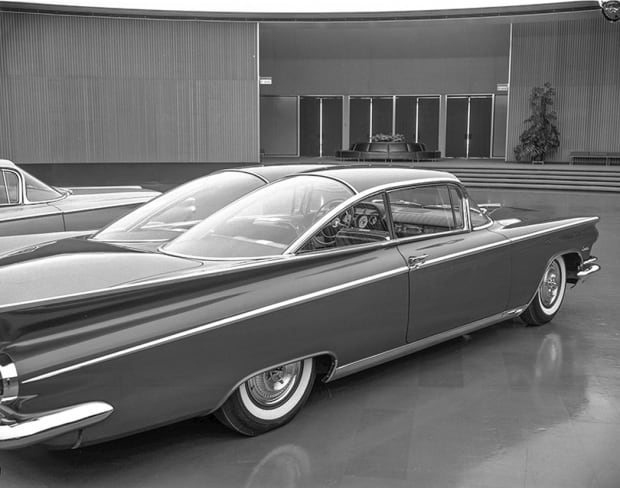
GM Media Archive
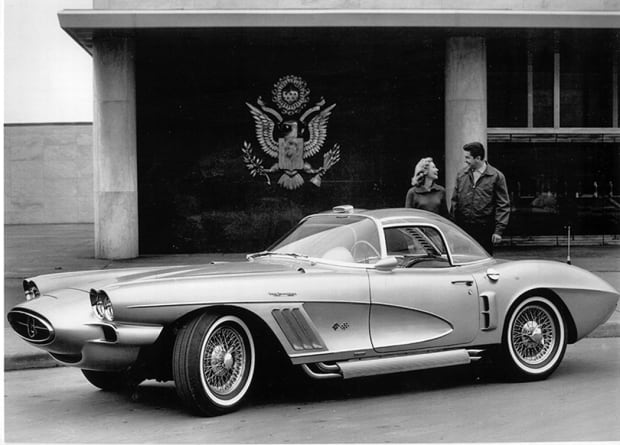
GM Media Archive
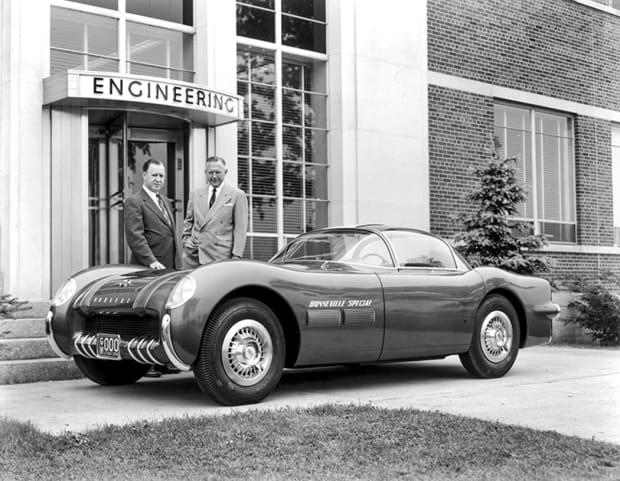
GM Media Archive
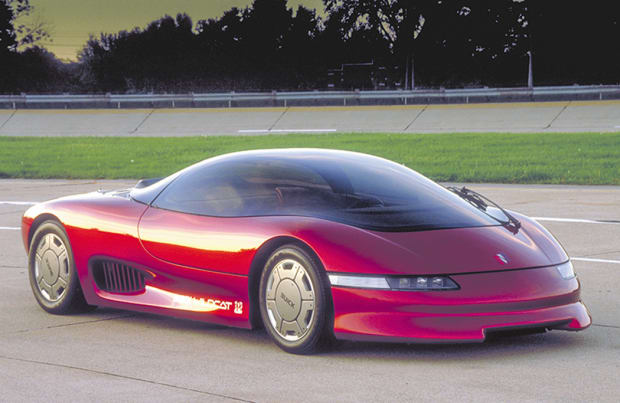
GM Media Archive
Chevrolet
To say the restyling of the 1961 Chevrolets was extensive would be an understatement. The dog-leg A-pillar and wraparound windshield used for the past six model years were gone. In their place were thin A and C pillars providing a larger glass area. Not only were the ’61 Chevys shorter, narrower and lower, the fins were gone, although the quarter panel shape and side spear molding carried a fin-like theme. A CARS magazine review observed, “A glance at the new Chevrolet for 1961 is certainly fair reward for the yearly wait. While retaining a distinct Chevy flavor, its styling has changed drastically… There is a remarkable feeling of unity and follow-through in the design.”
The 1961s looked rather sleek in any style, especially the two-door hardtop body, offered in not only the top-level Impala series, but also the second-tier Bel Air series — both with a bubble-like rear window. A special few of the Impalas wore “SS” (Super Sport) badges. The SS was an option package consisting of special emblems, sportier interior trim, passenger grab bar on the dash, four-speed manual transmission with a floor-shift trim plate, 7,000-rpm tach, three-bar spinner wheel covers and 8.00×14 thin-line whitewall tires. According to Chevrolet’s sales literature, the SS option was available on any Impala body style, though evidently in actual practice, only two-door models received the option from the factory. Under the hood of an Impala SS was one of three versions of the 348 with 305, 340 or 350 horsepower, or the very limited-production 409 introduced in January. Non-SS cars were available with six-cylinder power, the 283, or any of the 348s.
Chevys powered by the 409 did well in drag racing and finished first and third at the 1961 Pike’s Peak Hill Climb. Results such as these, as well as the SS option, gave Chevrolet a strong performance image that appealed to the growing youth market of the era.
Pontiac
Under the leadership of Semon “Bunkie” Knudsen, who was appointed general manager of the Pontiac Division in 1956, Pontiac received an image makeover. What was abundantly clear to Knudsen at that time was that Pontiac had a reputation as a reliable car, but not as an exciting one. “Reliable” was a positive trait; being dull was a big negative trait. Knudsen knew that, and is credited as saying, “You can sell a young man’s car to an old man, but you’ll never sell an old man’s car to a young man.” The growing youth market, which preferred an exciting kind of car, meant Pontiac had to receive an image makeover — and soon.
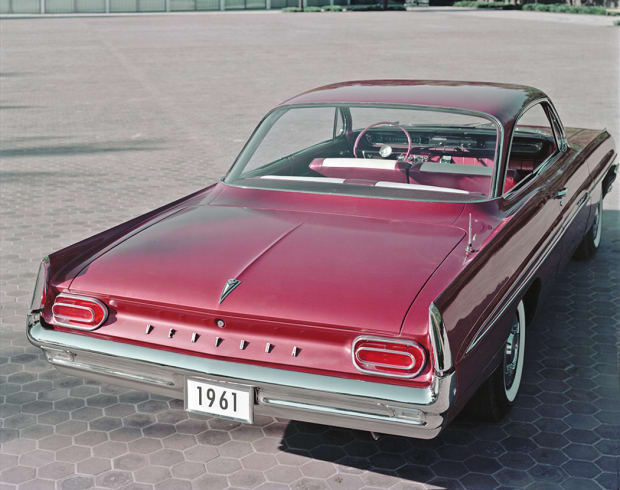
GM Media Archive
Prior to Knudsen’s promotion, Pontiac added the choice of a new modern V-8 for 1955, definitely a much-needed step in the right direction, as the public was largely sold on V-8 engines. The V-8, combined with an all-new design, resulted in skyrocketing Pontiac sales for 1955 and 1956. A limited-production Bonneville, offered only as a convertible powered by a fuel-injected V-8, served to enhance the image of Pontiac in 1957. The Bonneville became a mass-produced model with sporty traits for 1958, and the model went on to be the flagship of the Pontiac division for decades. Despite new Pontiac styling and publicity generated by the Bonneville, sales suffered in 1957 and 1958, but another all-new design for 1959 was a hit with the public. Its split grille — intended as a one-year-only styling feature — was brought back for 1961 and remained a hallmark of Pontiac until its demise in late-November 2009.
The “Wide Track” 1959 chassis, which pushed the wheels farther outward, substantially aided handling, though it was really intended as a styling gimmick to attract buyers. The same chassis returned for 1960.
Also popular for Pontiacs was the 389, another derivative of the 1955 287-cid V-8. The 389 was first offered for 1959, replacing the 371. For 1961, a variety of 389s, ranging from “economizing” to all-out performance, were offered to suit the varied tastes of Pontiac buyers. Output ratings spanned from 215 to 348 hp for street-driven cars, and up to 368 hp for the Super Duty 389. Offered late in the 1961 model year was the Super Duty 421 V-8 fed with high-octane fuel via dual carburetors; it was conservatively rated at 368 hp. A four-barrel version was rated at 373 hp. Both SD 421s, which had output suspected of being beyond 400 hp, were meant for drag-racing and NASCAR competition (where use of multiple carburetors was not allowed).
A new perimeter frame brought with it a slightly narrower chassis for 1961. However, the cars were nearly 4 inches shorter, giving them proportions nearly identical to the 1959 and 1960 models. These Pontiacs were also approximately 200 pounds lighter than the 1960s, with most of the weight savings due to the new perimeter frame. The suspension was redesigned with stronger lower control arms, a coil-spring rear suspension that employed four trailing links, and the large trailing A-arm was eliminated. With the suspension modifications and weight reduction, the ’61 Pontiacs provided better handling and much improved performance, something especially true with cars equipped with one of the high-output 389s or 421s.
Added to the lineup for 1960 was the Ventura. It was a Catalina-based model with Bonneville-style appointments for the interior, yet was understated on the exterior with less bright trim. The Ventura was exclusively offered as two- and four-door hardtops. The Ventura returned for ’61, and production was divided almost exactly 50/50 between the two body styles with 13,297 bubble-top two-door hardtops accounting for the 27,209 overall sales of the model in ’61. Of note is that a mere 1,940 Venturas were equipped with a four-speed transmission for the 1961 model year.
The May 1961 issue of Motor Life reported, “Standing-start acceleration or passing speeds in the 60-65 mph range are of the ‘push-you-back-in-the-seat’ variety that feel like rocket-assisted takeoffs… Stock suspension and chassis is more than adequate for drag racing and ideal for ordinary street and highway comfort… the front stabilizer bar and four-link rear suspension provide good cornering stability with little lean.” Their test car was one of those rare four-speed Venturas, which was powered by the 348-hp engine and had a 3.90:1 “Safe-T-Track” differential.
The redesigned Pontiacs ruled the 1961 Grand National circuit with 30 wins out of 52 starts, including the win by Marvin Panch at that year’s Daytona 500. Hayden Proffitt drove Mickey Thompson’s 421-powered car to an OS/S class win (12.55 seconds at 110.29 mph), and Pontiacs also won the three classes in the automatic transmission class that year in NHRA competition. The best time on the drag strip for the 1961 Pontiacs was achieved with a four-speed car — 13.13 seconds at 107.12 mph — but the automatics were generally more successful overall. Royal Pontiac sponsored the car that won Stock Eliminator at the NHRA Regionals at Muncie, Ind., and Alton, Ill.
Under the leadership of Knudsen, Pontiac finally moved away from being just a reliable, family-toting car to one with a much more youth-oriented image, thus boosting sales. After a roller-coaster ride from 1957 to 1960, Pontiac market share began trending upward for ’61, going from roughly 5.7 percent in ’60 to about 6 percent on sales of 372,871 cars.
Oldsmobile
For 1961, Oldsmobile’s major restyle resulted in front fenders and bumper ends that were blended to form a blunt, leading edge in the profile view, while bowing outward when seen from ahead. The straight front fender line ultimately turned downward in a gentle arc at the rear of the quarter panel, joining the upturned arc at the end of the crease in the lower quarter panel. Thus, the rear came to a point, or a rocket shape. This rocket shape was repeated with a matching recess in the side view. The lower rear part of the quarter panels had what were known by auto designers as “skegs” (a skeg, according the Merriam-Webster dictionary, is the stern of the keel of a ship near the sternpost, especially the part connecting the keel with the bottom of the rudderpost in a single-screw ship. It is also a fin situated on the rear bottom of a surfboard that is used for steering and stability.) The fin-like projection filled the region between the rear wheel opening and the rear bumper. The reverse waterfall grille, with paired headlamps at each end, slanted toward the radiator, and a bright panel with a series of faux vents spanned the space between the round taillamps. There was no mistaking a 1961 Oldsmobile for anything else on the road that year.
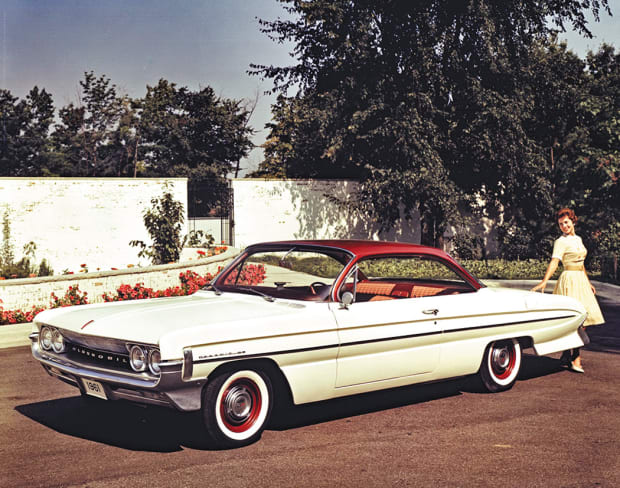
GM Media Archive
Under the hood of the ’61 Oldsmobiles was a new 394-cid V-8, an enlarged version of the previous year’s 371. Underneath the body was a new “Guard-Beam” frame with “Twin-Triangle Stability” with side rails running along the outside of the floor pans, and sturdy sections at the front and rear of the side rails comprised of four steel arms placed triangularly from axle housing to frame, hence the marketing lingo.
B-body “Holiday” two-door hardtops of the Eighty-Eight series were divided into two series: the more economical Dynamic 88, and the more upscale Super 88. The Dynamic 88 received the low-compression (8.75:1) 394 rated at 250 hp as standard equipment, while the Super 88 received the 325-hp “Skyrocket” version (10.0:1 compression); both series had a three-speed synchromesh manual transmission as standard issue, but the freshly redesigned Hydra-Matic was available as an option costing $231.
While Chevrolet and Pontiac grabbed the attention of performance car buffs, Oldsmobile’s heyday of NASCAR victories was very much behind it by this point. Comfortable transportation rather than impressive elapsed times was now the focus of Oldsmobile. The motoring press noted the ’61 Olds for its new styling, increased passenger comfort, smooth and quiet ride, and excellent handling characteristics.
Buick
Buick sales experienced a major slide in the late 1950s. Quality control became a problem when higher production was sought for 1956. Further hurting sales for all of the “Big Three” was an economic recession, which began in the latter part of 1957 and lasted well into 1958. Edward Ragsdale, who was appointed as the general manager of Buick in 1956, was replaced by Edward Rollert three years later. Rollert received a BS in chemical engineering from Purdue University. He began working for GM as a student engineer for the company’s AC Spark Plug Division before entering the military upon U.S. involvement in World War II. Upon leaving the service, he went to work for Elgin Watch, doubling its output through his improvements in manufacturing. Rollert returned to GM two years later.
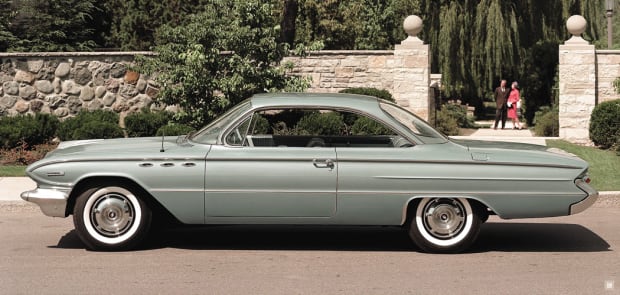
GM Media Archive
After being assigned to the top spot at Buick, Rollert brought in personnel from other GM divisions whom he knew to have a deep understanding of engineering and quality control. This was at the time the design of the 1961 Buicks was underway. Sales of the ’61 models began a rebound for Buick that, within just a few years, put the division back to the sales it had in the mid ’50s, and soon even surpassed that level.
Buick’s B-body models, the LeSabre and the more upmarket and performance-oriented Invicta, each included the two-door hardtop body style featuring the bubble-like rear window shared with their other B-body brethren. Underneath the all-new sheet metal of the full-size ’61 Buicks was a redesigned chassis with an X-frame dubbed “Safety-X.” It was only vaguely similar to the prior 1959-’60 X-frame. However, the latter included side rails in addition to an X-member. For 1961, the X-frame eliminated the side rails. The chassis for the B-body Buicks had a wheelbase 3 inches shorter than the C-body Buick at 123 inches.
A 364-cid V-8 was standard issue for the LeSabre while a bored-and-stroked version of the engine (which dated back to 1953), giving 401 cubic inches of displacement, was standard for the Invicta (as well as the Electra series). The only transmission offered for these Buicks was the “Turbine-Drive” automatic.
While the ’61 Buick was largely all-new, it did carryover one innovative feature from 1960 — the “Mirrormagic” speedometer. The bar-type speedometer used in prior years was hard for some drivers to read. The cars of this era lacked the multitude of seat adjustments that are common today, so an innovative solution was found by the designers. This was to have the speedometer reflect in an adjustable mirror, thus drivers short to tall could adjust the mirror position to an ideal angle using a thumb wheel.
Epilogue
The bubble-top theme was largely a thing of the past when GM’s ’62 models were designed. What was considered a more formal-looking notchback roof was now in vogue for GM’s B-body cars. Almost all 1962 GM two-door hardtops received a roof with a crease emulating the appearance of a raised convertible top. Chevrolet had the exception to the new roofline; it continued offering the bubble-top roof on the Bel Air Sport Coupe, reportedly because those racing Chevys in NASCAR wanted the aerodynamic advantage the sleek top offered.
GM’s cars of 1961 accounted for 47.6 percent of auto production that year — 1.1 percent more than for 1960, although short of 1959’s output. Even so, GM recorded record revenue of $12.74 billion for 1961. It was a good start for the new designs coming out of Bill Mitchell’s styling studios; the following year, GM accounted for a fraction over the 50 percent mark for U.S. automobile production.

SHOW US YOUR WHEELS!
If you’ve got an old car you love, we want to hear about it. Email us at oldcars@aimmedia.com
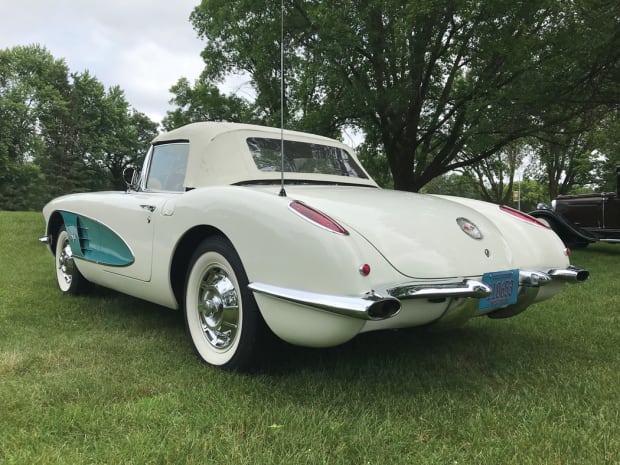
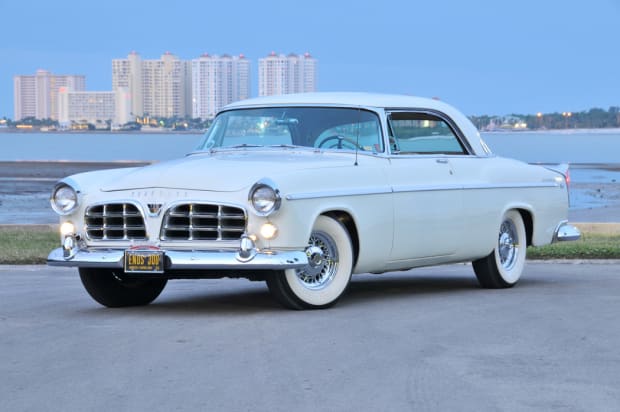
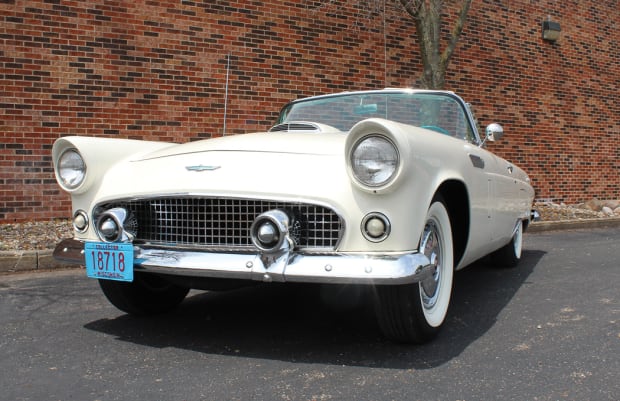

If you like stories like these and other classic car features, check out Old Cars magazine. CLICK HERE to subscribe.
Have you ever wondered what your classic ride is worth? Old Cars has you covered with the Old Cars Report Price Guide. We are your source for unbiased and real-world pricing. Subscribe today and find out what your car is really worth! CLICK HERE to subscribe.

View the original article to see embedded media.
*As an Amazon Associate, Old cars earns from qualifying purchases.
